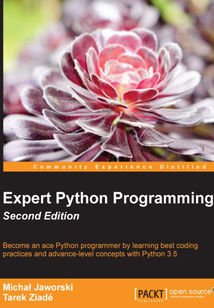目錄(105章)
倒序
- coverpage
- Expert Python Programming Second Edition
- Credits
- About the Authors
- About the Reviewer
- www.PacktPub.com
- eBooks discount offers and more
- Preface
- What this book covers
- What you need for this book
- Who this book is for
- Conventions
- Reader feedback
- Customer support
- Chapter 1. Current Status of Python
- Where are we now and where we are going?
- Why and how does Python change?
- Getting up to date with changes – PEP documents
- Python 3 adoption at the time of writing this book
- The main differences between Python 3 and Python 2
- Not only CPython
- Modern approaches to Python development
- Application-level isolation of Python environments
- System-level environment isolation
- Popular productivity tools
- Useful resources
- Summary
- Chapter 2. Syntax Best Practices – below the Class Level
- Python's built-in types
- Advanced syntax
- Other syntax elements you may not know yet
- Summary
- Chapter 3. Syntax Best Practices – above the Class Level
- Subclassing built-in types
- Accessing methods from superclasses
- Advanced attribute access patterns
- Metaprogramming
- Summary
- Chapter 4. Choosing Good Names
- PEP 8 and naming best practices
- Naming styles
- The naming guide
- Best practices for arguments
- Class names
- Module and package names
- Useful tools
- Summary
- Chapter 5. Writing a Package
- Creating a package
- Namespace packages
- Uploading a package
- Standalone executables
- Summary
- Chapter 6. Deploying Code
- The Twelve-Factor App
- Deployment automation using Fabric
- Your own package index or index mirror
- Common conventions and practices
- Code instrumentation and monitoring
- Summary
- Chapter 7. Python Extensions in Other Languages
- Different language means – C or C++
- Why you might want to use extensions
- Writing extensions
- Challenges
- Interfacing with dynamic libraries without extensions
- Summary
- Chapter 8. Managing Code
- Version control systems
- Continuous development processes
- Summary
- Chapter 9. Documenting Your Project
- The seven rules of technical writing
- A reStructuredText primer
- Building the documentation
- Making your own portfolio
- Summary
- Chapter 10. Test-Driven Development
- I don't test
- I do test
- Summary
- Chapter 11. Optimization – General Principles and Profiling Techniques
- The three rules of optimization
- Optimization strategy
- Finding bottlenecks
- Summary
- Chapter 12. Optimization – Some Powerful Techniques
- Reducing the complexity
- Simplifying
- Using collections
- Using architectural trade-offs
- Caching
- Summary
- Chapter 13. Concurrency
- Why concurrency?
- Multithreading
- Multiprocessing
- Asynchronous programming
- Summary
- Chapter 14. Useful Design Patterns
- Creational patterns
- Structural patterns
- Behavioral patterns
- Summary
- Index 更新時間:2021-07-16 10:58:24
推薦閱讀
- 簡單高效LATEX
- 認識編程:以Python語言講透編程的本質
- R語言游戲數據分析與挖掘
- DevOps Automation Cookbook
- Mastering PHP Design Patterns
- OpenShift在企業(yè)中的實踐:PaaS DevOps微服務(第2版)
- Hands-On Enterprise Automation with Python.
- 精通Python自動化編程
- Learning Unreal Engine Game Development
- OpenCV 3.0 Computer Vision with Java
- 寫給青少年的人工智能(Python版·微課視頻版)
- 算法超簡單:趣味游戲帶你輕松入門與實踐
- Web前端開發(fā)技術實踐指導教程
- Mastering Data Analysis with R
- Python自動化運維:技術與最佳實踐
- Unity與C++網絡游戲開發(fā)實戰(zhàn):基于VR、AI與分布式架構
- 中小企業(yè)網站建設與管理(靜態(tài)篇)
- Python機器學習技術:模型關系管理
- Python Machine Learning / Second Edition
- 輕松玩轉Scratch 3.0編程(第2版)
- 編程之美
- Learning IPython for Interactive Computing and Data Visualization
- Mastering Embedded Linux Programming(Second Edition)
- PHP內容管理系統(tǒng)
- Unity Virtual Reality Projects
- R數據可視化手冊(第2版)
- INSTANT Backbone.js Application Development
- Learning Xamarin Studio
- The Applied SQL Data Analytics Workshop
- 軟件靈活性設計:如何避免陷入編程困境


